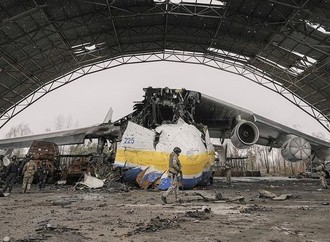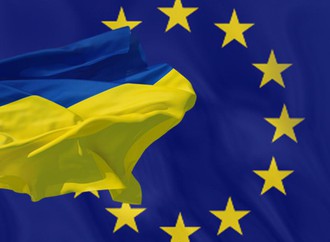The global economic system is increasingly characterized by the dependence on financial capital, which has been becoming dominant and determinant in the global resource distribution system. At the same time, global financial flows are based on disproportionate economic development and uneven balances of payment. Within this framework, the development of indebted Third World countries is subject to the displacement of financial capital from the borrower countries to the countries of the “core”. Ukraine has been consistently integrated into this global market chain as a provider of raw materials [Асоціація з ЄС: наслідки для економічного розвитку та ринку праці в Україні, ЦСТД, 2015].
Today, instead of looking for internal resources for development, the Ukrainian government adopts the course of a rapid buildup of external loans. However, the efficiency of such a method raises serious doubts, since loans will have to be paid back with interest; so the country is pushed towards the Greek scenario, in which financial «aid» will be provided in exchange for harsh austerity measures, and the country will end up not only in an unprecedented socio-economic crisis but also with a portfolio of multi-billion-dollar debts.
Given these circumstances, we think that it is time to examine the sensibility of such policies for the country’s development. We will test the well-known claim that accumulating debt is the only option, and assess the consequences of a possible default in Ukraine in economic, legal, and social terms. We will attempt to sketch some possible alternatives to the debt policy. To do that, we will review Ukraine’s debt policy in recent years, assess the impact of external loans on the state budget, overview the international experience of defaulting and define the possible social consequences of default in Ukraine.
The history of Ukraine’s credit relations since the moment it declared independence has been rather complicated. Its public debt was managed using a combination of administrative methods. That is why it is appropriate to divide the history of external loans up into several stages and to study the characteristics of each stage.
Entering the international loan market in 1991-2000
This stage was characterized by the unsystematic accumulation of public debt. External loans at this stage outweighed internal loans, and public loans outweighed private loans. The experience in credit resource management started to accumulate at this stage, and some attempts to design independent debt policies were made. When the USSR collapsed, Ukraine had no external debt, based on the “zero option” in the distribution of the liabilities and assets of the former USSR.
The country’s financial system in the early 1990s was characterized by a chronic budget deficit. It depended on imported energy, and the responsibility for the overdue debt for energy resources was transferred from the private to the public sector. Hyperinflation was managed by money emission. The government lacked experience in international credit relations, and there was no regulatory framework for those relations.
The introduction of the market, which broke the links within the single economic complex of Soviet republics, and the resulting decline in production led to diminished tax revenues and caused an acute budget deficit. As a result, the welfare budget shrank, the amount of unpaid wages in the public sector accumulated on a catastrophic scale, and so on. In that situation, to balance the budget deficit, the Ukrainian government asked external creditors for financial help, and its public debt started to accumulate rapidly (Figure 1).
Figure 1. The dynamics of public debt accumulation (as of the end of each year) for both internal and external crediting [based on the data provided by the Ministry of Finance, the National Bank of Ukraine, and the Accounting Chamber].
At the first stages, creditors from specific countries were involved, primarily from former Soviet republics. In the first three years, Ukraine’s external debt had already reached $3.6 billion, more than $2.7 billion of which was made of the loans that were officially attributed to the adjustment of the overdue debt to Russia. Since 1992, loans by the National Bank of Ukraine and public guarantees for international loans to Ukrainian companies had been issued. However, there was no clear mechanism for evaluating credit projects, which led to arbitrariness and corruption schemes. Decisions about giving loans were made by a small group of officials in the Currency and Monetary Board of the Cabinet of Ministers of Ukraine, without any competitive procedure or developed methodology; so the decisions were based on subjective methods of evaluation.
It is no less important that the state budget’s capacity to service the emerging government obligations at the agreed time was not assessed. For seven years, 1992 through 1999, public guarantees for loans totaling $2.4 billion were issued in these circumstances [Рахункова палата України, 2003]. Company debts, in their turn, were hardly ever paid back and got transferred to the state balance, pushing the country into a financial crisis in the future.
The evidence for the unsystematic nature of external debt accumulation in the first years of independence is provided by the fact that the Decree by the Cabinet of Ministers “On the priority directions for foreign loans”, which limited the practice of chaotic public guarantees and at least started the process of ordering the external credit relations and creating the tools for a reasonable debt policy, was only passed in the early 1995 [Постанова КМУ № 234, 1995]. At the same time, the internal market for government loans was barely developed, and the fraction of external debt reached 80 percent of the total structure of Ukraine’s public debt by 1996.
The desire to reach out to new markets of loan capital turned a new page in Ukraine’s external relations — its history of borrowing from international financial institutions (IFIs), including the World Bank, the International Monetary Fund (IMF), the International Bank for Reconstruction and Development (IBRD), and the European Bank for Reconstruction and Development (EBRD). Because of loans from these organizations, Ukraine’s external debt increased by $3.2 billion in 1995 only.
It is important to note that cooperation with the IMF has certain special features. The borrower country receives loans based not only on the general condition that it pays back its debt but also on the condition that it introduces some changes in its internal policies. According to the established policy of the IMF, the country that takes its loan has to implement neoliberal reforms; crucial outcomes of these reforms are that the social function of the state is reduced and all processes are abandoned to market “self-regulation.” In theory, such measures are supposed to improve the country’s solvency for international lenders, to stabilize its balance of payments and its budget deficit. However, global practice demonstrates that these relations are basically a tool to control a country’s development and impose the “dependent development” model on it, subordinating it to the countries of the «core».
Thus, the condition for receiving the first IMF loan was that the Ukrainian government signed the Memorandum on Economic Policy and Strategy in September 1994; this document launched the accelerated implementation of market relations in Ukraine. The Memorandum essentially limited the Ukrainian government’s independence in internal policy-making and determined the directions of development for Ukrainian society [Економічна безпека України, НІСД, 1997].
Among other things, the IMF demanded:
- to liberalize the foreign trade system;
- to liberalize the currency exchange rate and the pricing policy, particularly to reduce price controls;
- to cut subsidies and introduce a targeted welfare system;
- to accelerate the privatization of companies in the public sector;
- to restructure natural monopolies and particular companies;
- to reduce the budget deficit;
- to start deregulation and administrative reform.
Therefore, we can deduce that the implementation of the Memorandum was intended to integrate the Ukrainian economy into the global market as a country with developed raw material industries and a consumer of imported goods (to cancel indicative export prices, to cancel the requirements for certifying the quality of imported goods produced abroad, to organize wholesale privatization of export-oriented companies), and, simultaneously, to reduce the state’s social responsibility (to cut subsidies, to increase utility tariffs and administrative fees to make them profitable).
However, in practice, not all the conditions were met on the Ukrainian side, since the government realized that their full implementation would further exacerbate the socio-economic situation and threaten the very course of transition to the capitalist development track, as well as the ruling status of the elites. This was reflected in the fragmentary nature of the relations with the IMF: the Ukrainian side regularly interrupted and slowed down the implementation of the loan conditions, and, in return, the international credit institutions limited the amounts of funding.
As Ukraine entered international financial markets, the internal policy of its National Bank changed. Instead of large-scale money emissions, it began to attract credit funds using government bonds. In March 1995, the first auctions for placing domestic government bonds were organized; non-residents got access to these auctions via Ukrainian banks, and they bought out more than a half of the bonds [Рахункова плата України, 2001]. However, even if this instrument solved the problem of budget deficit in the short term, the high profitability of the bonds (40 to 65 percent annual interest) led to multiple overpayments of interest and created the need to borrow again because of the increase of the budget deficit in the future, when those loans were to be repaid. The situation was further complicated by the growth of the “commodity loan” debt to post-Soviet countries, primarily for gas and fuel; by 1995, Ukraine had accumulated $732 million of gas debt to Turkmenistan, and $1.4 billion gas debt to the Russian state company Gazprom.
In these circumstances, a new stage in the country’s financial system development started: the government introduced the national currency, hryvnia, in 1996. Although this move stabilized the situation to some extent, Ukraine’s public debt management policies did not contribute to debt reduction (Fig. 2).
Figure 2. The dynamics of accumulation of Ukraine’s external debt in 1993-99, by key credit sources [based on the data by the Ministry of Finances of Ukraine].
As we can see in Figure 2, the introduction of national currency provided an opportunity to expand the list of credit sources. Ukraine started to take loans in the international financial markets by issuing Eurobonds, taking loans from foreign commercial banks, and issuing external government loan bonds (EGLBs). Even as the IMF slowed down its lending due to another violation of the Fund’s economic policy conditions, Ukraine managed to bring in more than $0.5 billion from foreign commercial banks. And although these loans were more expensive (10 to 17 percent of annual interest) and had shorter repayment terms (1 to 3 years) because of the country’s low credit rating, the advantage was that this money could be used without any additional conditions. However, adding new sources of funding did not change the fact that new loans were taken to pay back the previously accumulated debt.
In 1997, the first place in the list of lenders to Ukraine was taken by international financial institutions, to whom Ukraine owned 42.3 percent of its external debt; 91.3 percent of these 42.3 percent were owed to the IMF and the World Bank. Another chunk of the debt burden was still owed to foreign governments — 34.8 percent, or $4.34 billion in 1999; more than $3 billion of this fraction was owed to Russian Federation. At the same time, the burden that the service of internal debt bonds placed on the state budget increased rapidly and started to dangerously resemble a financial pyramid, threatening the economy.
The situation with publicly guaranteed debt (foreign loans to various Ukrainian companies and organizations, including private ones, which were guaranteed by the government) also got out of control by the late 1990s. The cost of servicing (paying the interest) and repayment of the publicly guaranteed loans increased to 31 percent of the state’s total debt payments, including internal debt. Overdue debt, for which the government was held responsible, rapidly accumulated (Fig. 3).
Figure 3. The amount of overdue corporate debt guaranteed by the government in 1995-99 [based on the data by the Accounting Chamber of Ukraine]
According to the data provided by the Accounting Chamber of Ukraine, less than 15 percent of the companies that borrowed from foreign lenders paid their fees properly; about a third of them did not even try to pay back the loans they received. Interestingly, the overwhelming majority of this debt consisted of the obligations of Ukrainian companies to pay for the goods they imported from abroad.
Therefore, the state budget ended up subsidizing foreign manufacturers instead of helping to develop domestic production.
In general, the annual cost of servicing and paying back foreign loans, which constituted a lion’s share of Ukraine’s public debt, outweighed the new loan income already in 1995. Loans were taken to cover the budget deficit that was caused, among other things, by the need to pay for external debt service. The short-sighted debt policy in the situation of a global financial crisis led to a significant reduction of loan resources from both external and internal sources in 1998.
1999-2007. Restructuring and transition to a balanced public debt management policy
As a result of irresponsible financial management, by 1999, Ukraine’s public debt reached $15.3 billion, which exceeded the critically acceptable level of 60 percent of the GDP. The government proved unable to pay the accumulated debt. In 2000, the total amount of the required payments to the IMF alone exceeded all the currency reserves of the National Bank of Ukraine. The total payments for foreign public debt in 2000 were twice as high as the year before, reaching UAH 3.7 billion. The question of restructuring the foreign and the domestic debt, as well as of a fundamental change in debt policies, became rather urgent.
The first problem to be solved was the question of foreign and domestic debt to commercial lenders. In October 1999, the parliament, despite the Cabinet’s resistance, initiated a prohibition of taking new foreign loans under public guarantees [Про інформацію КМУ про структуру і динаміку державного боргу України]. The domestic government bonds payments were “voluntarily” transferred to new documents that had to be repaid in 2001 - 2004.
Special Eurobonds were issued for foreign holders of IGLBs. The obligation to pay back the external commercial debt was replaced with Eurobonds with 10 or 11 percent annual interest rates, which had to be repaid by 2007. International financial institutions had every reason to treat these steps as a sovereign default declaration, which caused the country’s credit rating to fall.
This raised the possibility that lenders would demand that Ukraine paid back the total amount of its external debt earlier. The central problem of external debt to foreign governments and the IMF had to be solved immediately. The negotiations with the Paris Club of creditors (19 developed economies that got together to regulate the debt owed to them by borrower countries) lasted until the summer of 2002. Ukraine managed to arrange the restructuring of $580 million of its debt, out of $980 million. To wrap it up, a 12-year delay of debt repayment was arranged, with a three-year grace period and repayment in 18 equal portions. The restructuring program also covered the foreign loan bonds of 1995, issued to pay for Russia’s gas. In general, Ukraine managed to reduce the debt burden on its budget in the short term; the total amount of Ukraine’s foreign debt was reduced by 17.1 percent in 2000.
In the case of the debt to Russia, an agreement was reached that the debt will be reduced by $1.13 billion. According to the treaty titled “On mutual payments related to dividing the Black Sea Fleet and the presence of Russia’s Black Sea Fleet in the Ukrainian territory,” the compensation for the ships, vessels, and watercraft received from Ukraine was to reach $526.5 million. Based on the same document, Russia reduced Ukraine’s debt for the supply of nuclear fuel for its nuclear power plants and petroleum products by a total of $450 million, because of the tactical nuclear weapons exported from Ukraine in 1992 [Про ратифікацію Угоди між Урядом України та РФ].
In addition, since January 1, 1998, a significant part of Ukraine’s debt to the Russian Federation was repaid by counting in the fee for the use of land plots, shore infrastructure, and bay waters by the Russian Black Sea Fleet, as well as the compensation for the environmental harm caused by its operations, and so on. It was agreed that the debt for Russian gas, which, at that point, was consumed by Ukraine without prepayment, covered by external public debt stocks, would be paid back by June 21, 2007 [Лісовенко, 2000].
It is worth noting that restructuring did not at all mean that Ukraine refused to pay its debts or that a part of the debt was written off. Restructuring simply eased the debt burden at the time and redistributed it over the future periods. Moreover, it led to additional expenses on public debt service (according to the Accounting Chamber’s assessment, the additional expenses amounted to $209 million). However, we must admit that the Ukrainian government won some time to make its move and attempt to develop a more balanced debt policy, as well as the time to review the principles of its relations with international creditors. For example, from 2000 on, the government’s refusal to implement the IMF’s demands to accelerate market reforms minimized Ukraine’s borrowing from the IMF (only $0.5 billion of the envisaged $1.8 billion were received in 2001-3); in 2002, Ukraine stopped taking the IMF loans altogether; and from 2004, the cooperation between Ukraine and the IMF was limited to consulting and technical services; no new loan programs were opened until 2008.
For similar reasons (demands to privatize energy companies, to increase energy fees for the general population, to “optimize” the system of benefits and subsidies), Ukraine’s cooperation with the World Bank Group, particularly with the International Bank for Reconstruction and Development, was also limited.
The Concept of the State Debt Policy for 2001-4 was developed and approved; it defined the preferred sources of funding, prioritized internal resources, and declared the need to reduce the debt burden, to prevent the further increase of foreign debt and create an efficient system of public debt management, to stop the uncontrolled accumulation of public debt, and to facilitate the coordination of executive government bodies, institutions, and organizations to achieve these goals [Постанова КМУ № 1483, 2000]. The indicated goals served as a basis for Ukraine’s debt policy in the following years.
As a consequence of the economic restoration, international distrust of the Ukrainian financial market disappeared. In 2004, several leading rating agencies raised Ukraine’s credit rating to B or B+ with a stable and positive forecast. It gave the government access to international stock markets and allowed it to place Ukraine’s Eurobonds with record-low annual rates of 6.9 percent. All of this led to reducing the debt pressure on the country’s economy (Fig. 4).
Figure 4. The ratio of Ukraine’s debt, its foreign-exchange reserves, and its GDP in 2000-15, as of the end of the year [based on the data provided by the Ministry of Finance of Ukraine and the National Bank of Ukraine].
As we can see, the ratio of public debt to GDP fell consistently after the restructuring and the change in financial policy priorities, from 61 percent in 1999 to the lowest point of 12 percent in 2007. The question is, how did Ukraine manage to achieve this change? What could cause its economic growth, apart from the change in the policy of dealing with international financial institutions? Maybe there was a radical rearrangement of the economy? Were any prospects of an economic breakthrough in high-tech industries created? Or did the country succeed in implementing a new model of social development based on improving the access to knowledge, innovative development, and increase investment into human capital? Unfortunately, this was not the case.
The answer lies primarily in the world market conjuncture favorable for the raw materials exported by Ukrainian companies. For example, a fraction of exports in the total volume of the sold products in the iron and steel industry reached 79 percent, and in the mechanical engineering industry, the exports reached 74 percent [Кравчук, 2014].
The revival of the industrial engineering industry was also extensive and happened without the proper upgrade of manufacturing facilities; the rate of investment in these facilities lagged far behind the investment in trade and other industries that bring quick profits.
Therefore, Ukraine’s mostly restorative economic growth was based on the remnants of the industrial potential created in the Soviet years (iron and steel, chemical industry, heavy mechanical engineering industry), which ended up in the hands of oligarchic groups after the privatization. True, that part of the product created within this model which was not sent offshore did increase the taxable base; it allowed to limit external lending and even gradually improve the living standard for the population. However, the increase in social transfers to the population (from 12 percent of all budget payments in 1999 to 22-28 percent in 2005-8) was not supported by any programs that would encourage the development of promising industries and did not promote the supply of consumer goods by national manufacturers [Геєць, 2009].
Development without a general technical upgrade (the level of depreciation of fixed assets reached 61 percent in 2008) was limited by definition [Держкомстат]. The principles of attracting credit funds also did not change. For example, in 2005, the fraction of loans taken to fund investment projects in the total amount of external borrowing (UAH 7.2 billion) was less than 15 percent, and the rest went to cover current payments and refinance the existing public debt.
It is important to understand how the factors that influenced the country’s financial stability changed. If during the transformation of the late 1990s the main cause of the crisis was the accumulation of public debt and public guarantees for questionable projects, since the mid-2000s, this role was played by the private sector. The situation in the global market helped speculative private capital to come to Ukraine. In particular, considerable funds were invested in the real estate market by foreign bank branches, and mostly in foreign currencies.
In general, in four years from 2005 to September 2008, the total amount of loans in foreign currencies increased twofold and reached a third of the country’s GDP [Шевчук, 2009]. At the end of 2006, the Ukrainian real estate market was valued at 400 percent of the country’s GDP, while even in the “bloated” US market this indicator was only 160 percent [Гриджук, 2006]. The fall of credit rates stimulated private individuals to accumulate consumer loans.
Meanwhile, the National Bank’s policy was not to interfere in these dangerous processes. It all led to increasing import dependence; the economy started to depend on foreign currency, the balance of payments became negative, and capital started to flow out of the country; all this laid the foundation for the future crisis. An “overheated growth bubble” emerged, and it was bound to burst sooner or later. The transition of the world financial crisis into an active phase in 2008 caused a sudden halt; that is, private capital started to flee the Ukrainian market en masse, and both domestic and foreign demand for Ukrainian products was reduced. Once again, Ukraine faced the issue of aid from international financial institutions.
Thus, in the mid-2000s, the commercial sector played the same destructive role in the financial and economic stability of the country as the public sector in the 1990s, once again pushing Ukraine to curtail its economic independence and to engage in another round of foreign debt accumulation.
2008-2013. Resuming active cooperation with international financial institutions under conditions of a financial crisis
After this, debt policies were based on the previously accumulated disproportions in the economy and, at the same time, on the attempts to maintain the pre-crisis level of individual consumption. All of this was a part of carrying on with neoliberal policies that did not involve any alternative economic instruments for changing the model of socio-economic development.
The economic crisis left limited sources for funding the budget deficit in the situation of a decrease in production and, therefore, a shrinking taxable base. The first source of funding was to use the accumulated foreign exchange reserves which, by 2007, reached a considerable amount of $31.5 billion. In 2008-13, the forex reserves were reduced by 37 percent, down to $20.4 billion. As for the second source, already in 2008, the government asked international financial institutions for large-scale aid packages.
The newly resumes IMF loans were based on a “standby” program, according to which Ukraine received $14.4 billion in 2008-10. In 2008, it received an urgent loan of $0.8 billion from the World Bank to cover the budget deficit. These tranches were traditionally aimed not to facilitate development, but to cover current expenses, and already in 2012-13 they led to peak external debt payments: $3.7 billion in 2012 and $5.7 billion in 2013 [Міністерство фінансів, НБУ] (table 1).
Table 1
The trends in public and publicly guaranteed debt and the fraction of the IMF debt in it ($ billion)
As the table demonstrates, by the end of 2009, the IMF debt reached $8.5 billion. Trying to diversify the sources of funding, the government also took domestic loans on an equally large scale: internal debt increased from $5.8 billion in 2008 to $17.8 billion in a year from that point. We must also note that a considerable part of the internal public debt stocks is still in the hands of non-Ukrainian residents. It means that not including them in the count of external debt distorts the actual scale of Ukraine’s dependence on creditors.
When the financial and economic situation stabilized and the global demand for Ukrainian product recovered, attempts were made to develop strategies with the aim to reduce external funding [Середньострокова стратегія управління державним боргом на 2013-2015 роки]. In particular, the program included reducing the fraction of foreign debt to 50 percent; accelerating the repayment of public loans, and setting the limits for public debt refinancing and its maximum limit of 31 percent of Ukrainian GDP. However, despite these attempts, the program could not be effective without a radical restructuring of the economic system, without preventing the capital from flowing out and investing it into economic development, without using loans as intended, to fund innovative development.
Going back to the analysis of the debt burden, let us analyze the balance of payments and revenues for foreign loans in recent years (Fig. 5).
Figure 5. The balance of payments and revenues for Ukraine’s public debt in 2007-14 [based on the data provided by the State Treasury of Ukraine]
Therefore, as the figure demonstrates, the debt accumulated in 2009-10 led to a threatening situation in 2011, and new external loans were more or less equal to the payments for older loans. If we take into account internal debt payments, we can conclude that this version of budget funding is excessively burdensome, because internal resources are diverted from their possible use for socio-economic development to service the debt burden.
In this situation, Ukraine approaches a sharp turn in its economic policy, including the financial policy, after its government changed after the tragic events of the winter 2014.
2014 - ... From Ukraine’s own debt policy to total dependence on the IMF’s orders
Since the beginning of 2014, the new government has radically changed the principles of public debt management. The role of foreign consultants becomes more important, the IMF consultants are introduced into the administrative structures of the National Bank, foreign experts are invited to join the government, and they have become responsible, among other things, for Ukraine’s debt discipline about international financial institutions.
The military conflict in the east of Ukraine and the increase in military spending caused by it, the dubious regulatory policy of the National Bank, the mass capital flight from Ukraine — all of these together led to a large-scale financial and economic crisis, and the National Bank’s foreign exchange reserves declined in 2014 from $20.4 to $7.5 billion. Once again, Ukraine asked international institutions for a considerable financial aid package. As a result, the external debt of government bodies and the National Bank in 2014 reached $35.1 billion because of the loans from the EU (€1.6 billion), Canada (US$0.2 billion), and Japan ($0.1 billion). In addition, as a part of the Standby program, Ukraine received $4.6 billion in 2014, $3.7 billion of which were paid back to the IMF for Ukraine’s old debt; in addition, Ukraine received $1.3 billion from the World Bank [звіт НБУ 2014 рік].
The size of the debt burden can be assessed using the data provided by the Ministry of Finance of Ukraine, calculated at the beginning of 2014 with the exchange rate of UAH 7.99 for one US dollar (Fig. 6).
Figure 5. The predicted amount of payments for foreign public debt repayment and service in 2015-25, as of the beginning of February 2014 [based on the data provided by the Ministry of Finance].
The total amount of payments for all of Ukraine’s foreign credit agreements was estimated to reach $30 billion, with peak payments in the current year and 2017. By now, this number has increased in the hryvnia equivalent after the devaluation and has been supplemented by new debt obligations. If we compare the borrowing in 2014 with the experience of 2009-10, we can argue that the situation would not have become uncontrollable, if not for the triple devaluation of hryvnia. And, since about 55 percent of the public debt was concentrated in foreign currency, its re-assessment led to the situation when, in 2015, Ukraine’s public debt, including new loans, is set to reach UAH 1,394,430,819,300, which will be equal to the predicted level of the country’s gross domestic product [Бюджет України, 2015].
The payments for public debt service in 2015 reached UAH 92.7 billion (UAH 46.3 billion more than the 2014 plan). This number is equal to 16 percent of budget expenditures, and it is too high a price for the “borrowed life,” since the payment of public debt interest alone became the largest item of budget expenditure in 2015. The direct debt burden on Ukraine’s population of working age also increased (Fig. 7).
Fig. 7. The dynamics of external debt burden per one employed person in the Ukrainian economy [based on the data provided by the State Statistics Service and the State Treasury Department of Ukraine].
Therefore, in 2014, about UAH 3,300 were paid for foreign debt per one working person, and in 2015, almost UAH 16,600 was paid per person; thus, it reached 56 times the amount of 2007 and more than 7 times the amount of 2013.
The logical consequence of this is that all of Ukraine’s credit ratings fell, and its debt obligations were assessed as default or pre-default in 2015. In practical terms, this means that Ukraine will have limited access to commercial borrowing abroad or, at best, that commercial foreign loans will be given with high-interest rates. In these circumstances, if the current policy is further pursued, the government can only count on financial support from the IMF. To secure it, the government agrees to nearly all of the IMF’s requirements about its internal economic policy.
If earlier Ukrainian leaders tried to maneuver between geopolitical blocs and implemented austerity policies only selectively, the current government has declared their full surrender and is determined to implement the harshest requirements of international institutions. As a result, in March 2015, Ukraine received the first tranche of $5 billion as a part of the new Extended Fund Facility program, which provides $17.5 billion of funding.
In the fall of 2015, the agreement was reached about postponing some of the payments to commercial lenders for three years and writing off 20 percent of the principal. Of course, it allowed to stabilize the situation in the financial market and to ease the debt burden, to some extent. But what is the price of these measures? For, according to them, Ukraine de facto loses its capacity to independently make its own financial and economic policies and commits itself to implement a harsh agenda of cuts in the social sphere. The basis for such a claim is the requirements listed among the latest obligations to the IMF which the government is going to undertake. According to the Memorandum, the IMF will exercise close oversight of all the processes that Ukraine will implement in its fiscal, tax, and monetary policies; this will, among other things, lead to all-encompassing welfare cuts, to be able to pay the IMF.
The restructuring of Ukrainian debt, which the government has to organize now, primarily benefits the lenders whose chances for returns on their investment are held up. Just as in with the previous restructurings, such actions only postpone the country’s bankruptcy, limiting its independence with a debt yoke, without raising the key question of a complete refusal to pay for illegal and unmanageable debts accumulated by all the previous "elites". Furthermore, the conditions for the restructuring include linking future payments to creditors to the rate of the Ukrainian economy’s growth. Thus, Ukraine will be forced to pay creditors 15 percent of its GDP increase over 3 percent, and 40 percent of each percent of the GDP increase over 4 percent.
However, in this case, there is the question of the role of the "people’s" government, if the citizens’ interests are secondary to the dictates of international capital.
References:
Аналіз стану реструктуризації державних зовнішніх боргових зобов’язань. Рахункова плата України, 2001. Доступ 27.04.15 за адресою: [link].
Д. Гриджук. Перспективи використання зовнішніх запозичень з метою фінансування житлового будівництва / Д. Гриджук // Вісник НБУ. – 2006. – № 10. – C. 6–9.
Економічна безпека України: сутність і напрямки забезпечення. Національний інститут стратегічних досліджень, 1997. Доступ 27.04.15 за адресою: [link].
Закон України «Про державний бюджет України на 2015 рік». Відомості Верховної Ради (ВВР), 2015, № 5, с. 37.
Закон України «Про ратифікацію Угоди між Урядом України і Урядом Російської Федерації про взаємні розрахунки, пов’язані з поділом Чорноморського флоту та перебуванням Чорноморського флоту Російської Федерації на території України». Офіційний вісник України від 14.05.1999 р., № 17, с. 13.
Зовнішній борг України на кінець 2014 року. Звіт Національного Банку України. Доступ 27.04.2015 за адресою: [link].
Кравчук О. В. Можливі соціально-економічні наслідки євроінтеграції для України. Журнал соціальної критики Commons, 2015. Доступ 27.04.2015 за адресою: [link].
Лист про наміри до МВФ та Меморандум про економічну та фінансову політику України від 11 березня 2015 року. Доступ 27.04.15 за адресою: [link]
Лісовенко В. Державний зовнішній борг України: етапи формування та розвитку // Вісник НБУ. – 2000. – № 9. – С. 35-36.
Офіційна інтернет-сторінка Державна служби статистики України. Доступ 27.04.2015 за адресою: [link]
Офіційна інтернет-сторінка Міністерство фінансів України. Доступ 27.04.2015 за адресою:[link]
Офіційна інтернет-сторінка Національного банку України. Доступ 27.04.2015 за адресою: [link]
Офіційна інтернет-сторінка Офіційна інтернет-сторінка Державної казначейської служби України [link].
Постанова Верховної Ради України «Про інформацію Кабінету Міністрів України про структуру і динаміку державного боргу України». Відомості Верховної Ради України (ВВР), 1998, № 52, с. 330.
Постанова Кабінету Міністрів України «Про затвердження Середньострокової стратегії управління державним боргом на 2013-2015 роки». Урядовий кур’єр від 22.05.2013, № 89.
Постанова Кабінету Міністрів України «Про схвалення Концепції державної боргової політики на 2001 – 2004 роки» № 1483 від 28.09.2000 р. Офіційний вісник України від 20.10.2000 р., № 40, с. 27.
Постанова Кабінету Міністрів України від 3 квітня 1995 р. № 234 «Про пріоритетні напрями використання іноземних кредитів». ЗП України, 1995 р., № 6, с 160.
Про результати аналізу причин та фінансових наслідків реструктуризації зовнішніх боргових зобов’язань України перед органами управління іноземних держав-членів Паризького клубу кредиторів / Підготовлено департаментом контролю державного боргу та діяльності банківських установ і затверджено постановою Колегії Рахункової палати від 28.02.2003 № 4-1 / – Київ: Рахункова палата України, 2003. – Випуск 10.
Соціально-економічний стан України: наслідки для народу та держави: національна доповідь / за заг. ред. В. М. Гейця [та ін.]. – К.: НВЦ НБУВ, 2009 – 687 с.
Українська призма: співпраця України з міжнародними організаціями. Дослідження фонду ім. Фрідріха Еберта. Доступ 27.04.2015 за адресою:[link].
Фурманець К. Л. Формування зовнішнього державного боргу Україн та фінансовий механізм його регулювання в умовах глобалізації. Вісник Вінницького політехнічного інституту. 2013. № 1. С 49-55.
Шевчук В. О. Макроекономічні ризики прискореної акумуляції зовнішнього боргу в економіці України. Доступ 27.04.2015 за адресою: [link].







